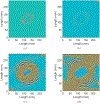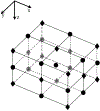Lebedev scheme for ultrasound simulation in composites
- PMID: 29407279
- PMCID: PMC6688188
- DOI: 10.1016/j.ultras.2018.01.013
Lebedev scheme for ultrasound simulation in composites
Abstract
The growing use of composite materials for aerospace applications has resulted in a need for quantitative nondestructive evaluation (NDE) methods appropriate for characterizing damage in composite components. NDE simulation tools, such as ultrasound models, can aid in enabling optimized inspection methods and establishing confidence in inspection capabilities. In this paper a mathematical approach using the Lebedev Finite Difference (LFD) method is presented for ultrasonic wave simulation in composites. Boundary condition equations for implementing stress-free boundaries (necessary for simulation of NDE scenarios) are also presented. Quantitative comparisons between LFD guided wave ultrasound simulation results, experimental guided wave data, and dispersion curves are described. Additionally, stability tests are performed to establish the LFD code behavior in the presence of stress-free boundaries and low-symmetry anisotropy. Results show that LFD is an appropriate approach for simulating ultrasound in anisotropic composite materials and that the method is stable in the presence of low-symmetry anisotropy and stress-free boundaries. Studies presented in this paper include guided wave simulation in hexagonal, monoclinic, triclinic and layered composite laminates.
Keywords: Composite; Guided wave; Lebedev method; Simulation.
Published by Elsevier B.V.
Figures













References
-
- Leckey C, Seebo J, Guided wave energy trapping to detect hidden multilayer delamination damage, Rev Progr Quant Nondestr AIP Publishing, 1650 (2015) 1162–1169.
-
- Fellinger F, Langenberg KJ, Numerical techniques for elastic wave propagation and scattering, Proc IUTAM Sym (1990) 81–86.
-
- Marklein R, The finite integration technique as a general tool to compute acoustic, electromagnetic, elastodynamic, and coupled wave fields, Rev Radio Sci: 1999-2002 URSI, edited by Stone W, IEEE Press and John Wiley and Sons, New York, pp. 201–244 (2002).
-
- Schubert F, Peiffer A, Kohler B, Sanderson T, The elastodynamic finite integration technique for waves in cylindrical geometries, J Acoust Soc Am 104 (1998) 2604–2614.
-
- Halkjaer S, Elastic wave propagation in anisotropic inhomogeneous materials, Ph.D. dissertation, Technical University of Denmark, Lyngby Denmark: (available from http://www2.imm.dtu.dk/documents/ftp/phdliste/phd74.abstract.html, date last viewed: 5/17/2012) (2000).
Grants and funding
LinkOut - more resources
Full Text Sources
Other Literature Sources

